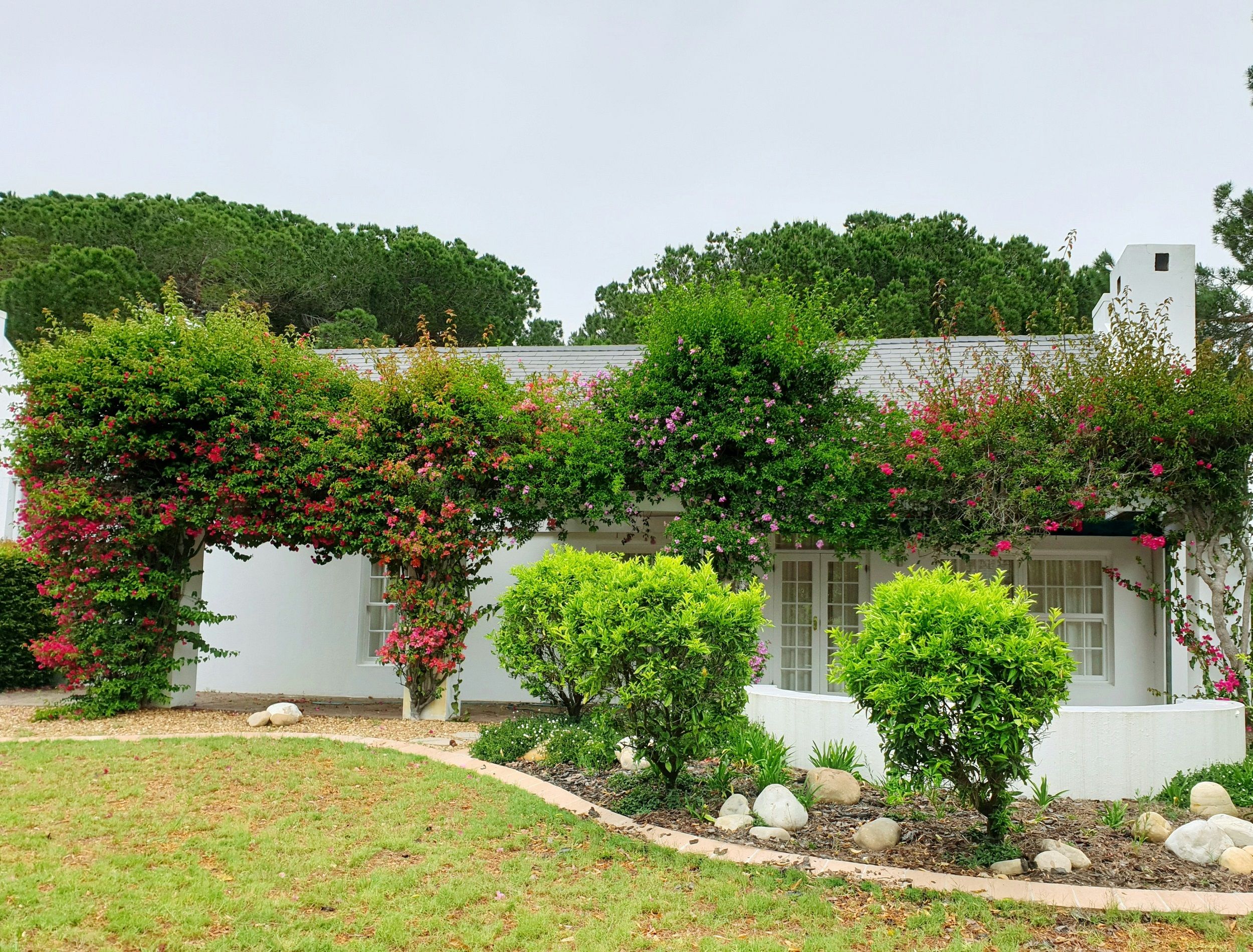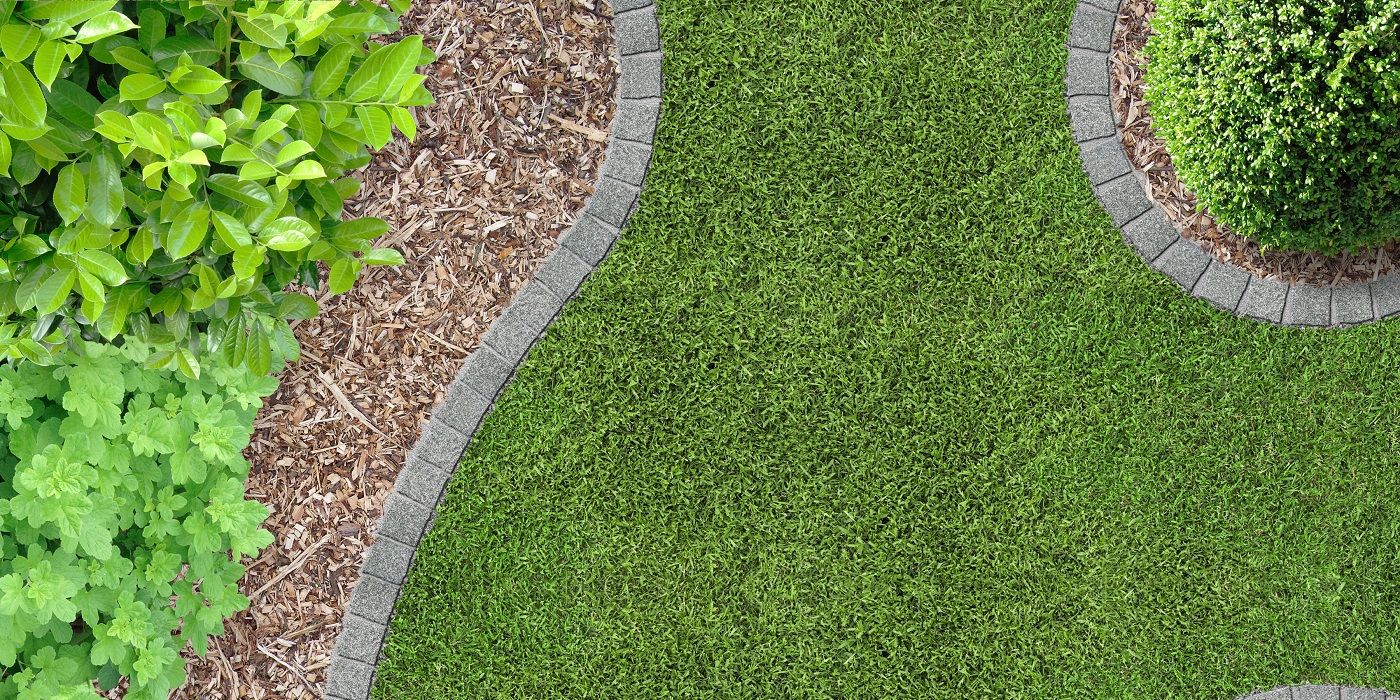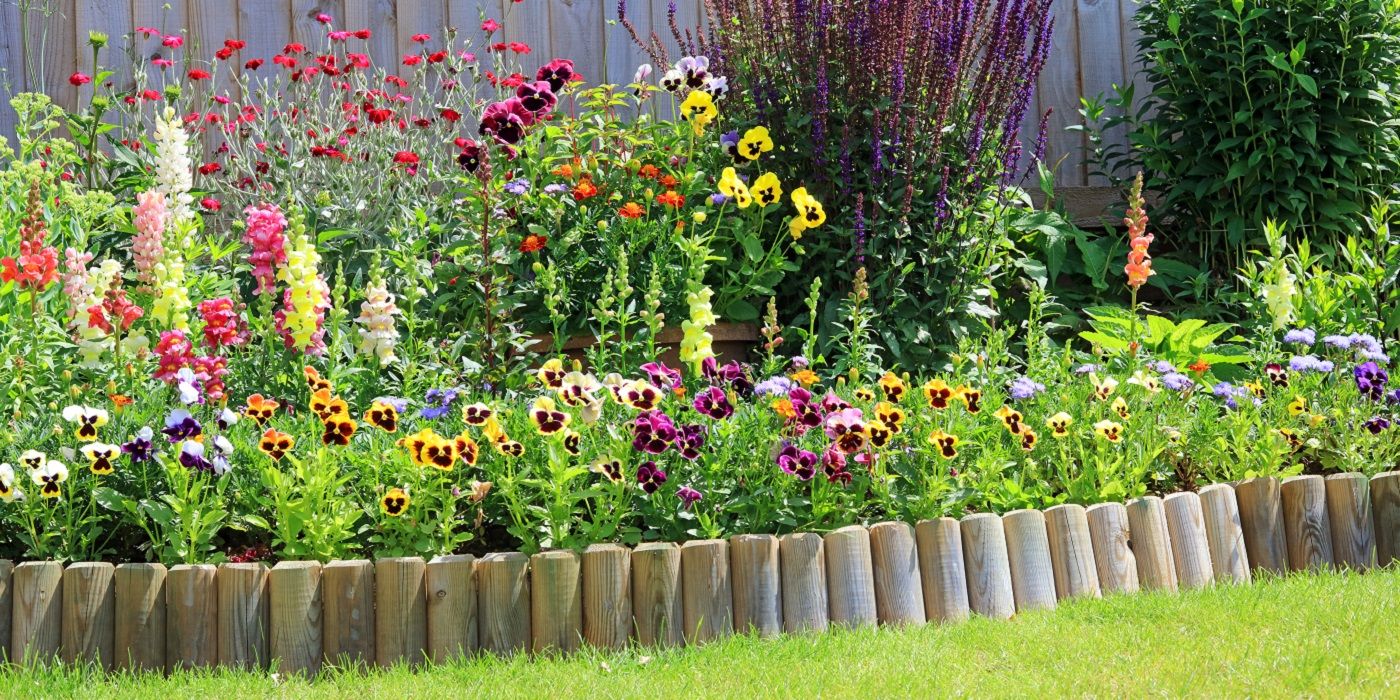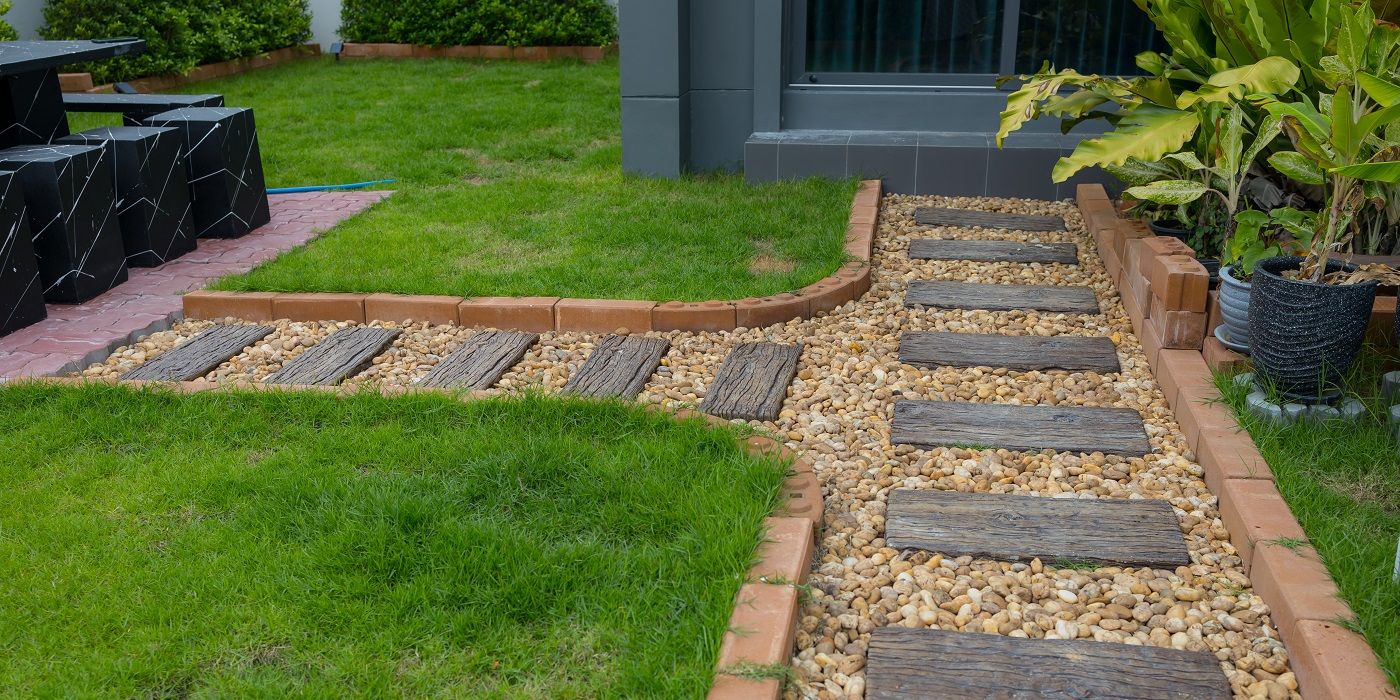Key Takeaways
- Get creative with garden borders! Materials like brick, plastic, concrete, wood, stone, and wattle can be used for unique garden edging designs.
- Incorporate different materials by mixing and matching wood and stone for a modern home design, or use plates and glass bottles for a personalized DIY look.
- Use rope lighting or LED strips to create a glowing effect in your garden and add ambiance to your outdoor spaces.
Garden edging is an essential element of any well-designed outdoor landscape. Most outdoor spaces consist of areas that serve different purposes, such as a patio, lawn, lounging area, and garden. Landscape edging and garden borders help section off these spaces while still creating a unifying design. Use creative modern garden edging ideas to add distinction to outdoor areas, defining spaces while creating a gorgeous overall look.
Use your DIY skills and budget to create the best edging designs for your spaces. You have lots of options for cheap garden border ideas or more costly designs.
Types of Garden Edging Materials
Get creative with garden borders
The best edging for your space will match your existing home exterior, fit within your budget, and be well within your realm of DIY ability or within your budget to hire labor to install it. Almost anything can become a garden border when you get creative and experiment with cheap modern garden edging ideas. Several materials are found in landscape edging of all kinds. Stick to these more traditional options or branch out on your own with a cool, creative idea.
- Brick is a long-lasting garden edging material that comes in a variety of styles and achieves a uniform look.
- Plastic, or composite, is a durable and flexible material but comes in many grades, which affects the quality of finished garden borders.
- Concrete comes available in sections of concrete edging ready to be set in place, or you can make your own concrete forms to make a custom design. You can even try cinderblock, which is an affordable DIY material that can be used in lots of garden projects.
- Wood is great for edging designs with straight lines and gives off a more organic look. Good quality wood doesn't come cheap but is known to withstand outdoor conditions well. Play around with different ways to create borders with wood to create a custom garden design.
- Stone is the most versatile edging material and one of the most durable options. Stone can be set in mortar for a permanent and refined look, or more temporarily placed for later adjustment.
- Wattle is seen commonly in fences, but it works well for landscape edging and garden border designs of all kinds. Wattle is made up of stakes that are laced with twigs and branches, a design that creates a rustic, natural look.
Modern Garden Edging Ideas
Defining your spaces with contemporary style
Play around with different materials and creative modern garden edging ideas to give your outdoor spaces a unique look. Incorporating different colors and textures into landscaping and garden beds is a great way to complement the natural beauty created by the plants and flowers in your existing landscape.
Repurpose Plates and Glass Bottles
All sizes and designs of crockery come into play in this garden edging design. Incorporate the decorous features of fine china or the crystalline quality of wine bottles for a custom DIY look. Not only is this an affordable way to edge garden beds, but this edging idea is also a great way to recycle glass and porcelain, all the while giving your garden a bit of character through a personalized selection of glassware. Use plates to section off your plants from your lawn or create a border of wine bottles to make space for a mulch pathway.
Save your own old, chipped, and cracked dishes and glass or shop for plates and other ending items at secondhand stores to make this cheap modern garden edging idea come to life.
Customize Your Borders With Wooden Planks
Use planks to build wooden panels arranged in a pattern that edges the lawn while creating a raised bed for ornamental plants. The selection of the wood is important, as it brings a rustic element to the layout with its marked texture and slight discoloration. Trade in the rustic look for a more polished texture. Choose stained planks, or stain them yourself, to give your outdoor spaces the look you want. Wooden planks offer a subtle and pretty transition between the various areas in any backyard or lawn and they're one of the easiest types of landscape edging to install.
You may need to shape the lawn or garden beds to accommodate the placement of wood, which is not as flexible as other garden border options.
Mix and match different edging materials if you like. Wood and stone look good together in a modern home design, but only if they're paired evenly. Too much wood and too little stone will take away the aesthetic stone can bring to your garden. If you'd like to pair wood and stone together, try using wooden stakes and stone to create a rustic, more cottage-like look.
Place Contrasting Tiles to Create a Striking Design
Tiles are a timeless design tool both in and outside the home. Tiles come in so many sizes, designs, and finishes, the composition possibilities seem endless! It's possible to create any color pattern or texture in your outdoor spaces using tile, a material that is easy to work with. Placing tile, even in the garden, can be a time-consuming task, but it is a skill that just about anyone can learn to DIY to create all sorts of cheap garden border designs that look amazing.
Look for end-of-season sales events when home improvement stores try to get rid of tiles for cheap prices to make way for newer tile styles. If you don't mind using last season's tile design, you can get some great deals.
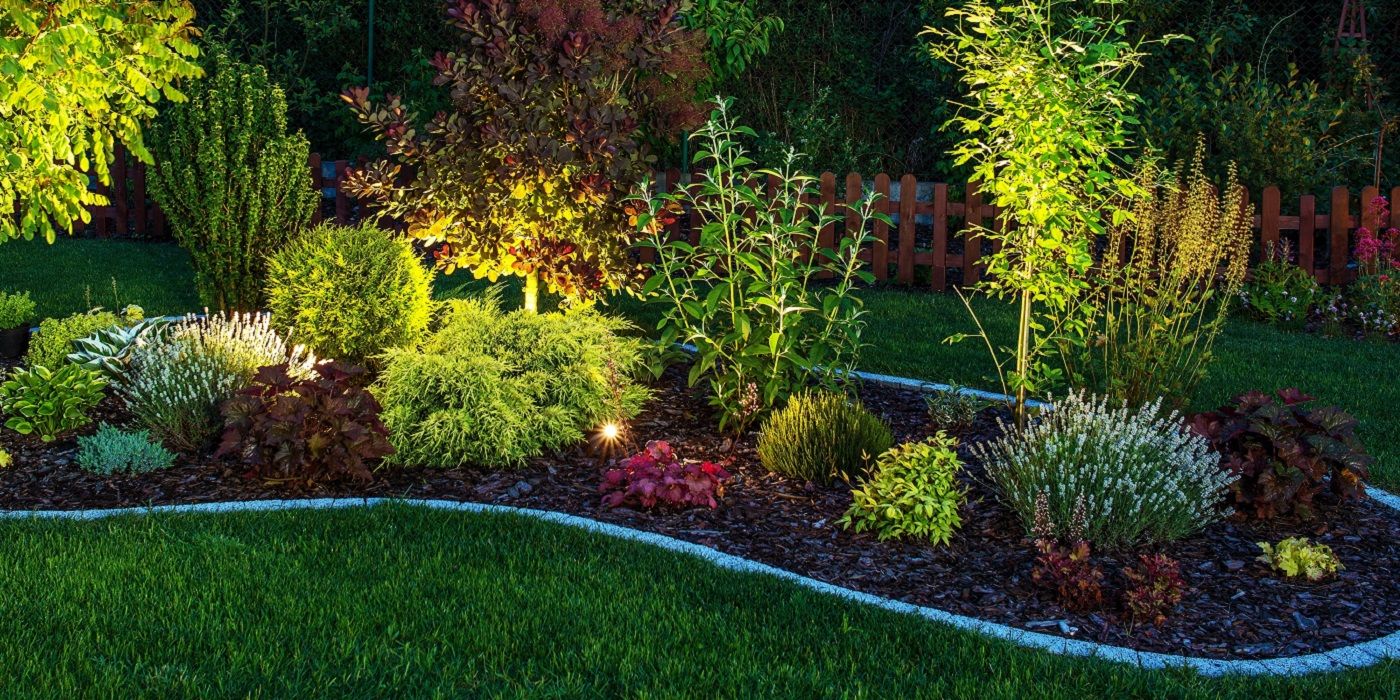 Light It Up to Make Your Garden Glow
Light It Up to Make Your Garden Glow
Illuminate your garden with a brilliant, affordable edging idea: rope lighting! It's easy to place and highly flexible, so it will follow any curve or bend in your yard. Fluorescent rope lighting just glows with modernity as it curves with the border of the lawn. Rope lights and LED strips are incredibly versatile, and they're great options for outdoor lighting. These lights are encased in a thick, transparent round plastic tube that is flexible, durable, and heat-resistant. They are also water-resistant, which makes them safe for outdoor use.
Some LED light strips come with the option of changing colors, so you can go for bright colors for a fun atmosphere or warmer colors for a relaxed mood.
- Lighting creates ambiance in outdoor spaces.
- When setting up lighting, install rope lights or LED strips with cable clips. These can be nailed into place around the lights or attached with hot glue to concrete, wood, brick, or glass.
- Small cable clips fit around rope lights or strips and secure to the material underneath, which can be pavement, dirt, wood, etc.
How about glow-in-the-dark landscape edging? Solar-powered lighting spares you the need to run wires or colds to connect to a power source. They're perfect for gardens that receive a good amount of sunlight as UV rays from the sun charge them up, so they glow in the night. Lights may not be your first thought in different types of garden edging, but this is a simple and beautiful way to add definition to garden spaces.
Glow-in-the-dark products with zinc will glow for up to 30 minutes, whereas those with strontium aluminate will glow for 12 hours!
Build Raised Garden Beds
Use raised beds to edge your garden and add visual interest to your layout. Raised garden beds are framed to enclose sprawling vegetation of all kinds. A significant aspect of this edging design is that you can choose which plants to feature in raised beds, which gives you the freedom to get creative and design little mini-themes. Go for an arid theme and grow succulents and cacti, or dedicate the beds to colorful hydrangeas and other brightly-colored flowers for a cheerful springtime look.
Raised garden beds can be constructed out of brick, stone, wood, cinderblock, and any material that will stay secure and hold plants and soil well.
Go Boulder and Get Edgier
When it comes to edging with boulders, a good rule of thumb is to go big. Although these large masses of rock may be intimidating to work with, they offer a natural feel to your landscape and create a stunning look. The neutral tone of natural stone can balance out the saturated greens of a garden and add more interest to the layout.
- When incorporating boulders into any landscaping design, place them on gravel so that they hold their position.
- Not only can boulders edge your garden beautifully, but they can also act as a retaining wall for other plants and they look great on a sloped landscape.
- Boulders for landscape edging come in many sizes, but they weigh, on average, 50 pounds to 250 pounds or more! Start with small boulders that weigh between 50 and 100 pounds. Anything above that requires professional landscaping services.
Do not lift anything that causes you to strain the muscles of your back, legs, shoulders, or arms. Seek help when you need it and don't try to lift more than you are able.
Edging With Hedges in a Natural Design
Hedges are a classic landscaping plant and a canvas for horticultural creativity of all kinds. Shrubs come in many sizes and leaf patterns and can be pruned to add visual interest to a garden. Edge your garden with an assortment of boxwood shrubs, purple sage hedges, and silky dogwood plants for a rich compilation of color and texture. Look for shrubs that grow well in your region to ensure they can handle your weather.
|
Boxwood shrubs (Buxus) |
USDA Hardiness Zone 5 to 9 |
Boxwood, or box shrubs, grow from 1 to 20 feet tall and 2 to 8 feet wide. |
|
Purple sage (Salvia) |
USDA Hardiness Zone 6 to 9 |
Purple sage grows from 1 to 1 ½ feet wide and 1 to 2 feet tall. It blooms with purple-blue flowers in May and June. |
|
Silky dogwood (Cornus amomum) |
USDA Hardiness Zones 5 to 8 |
Silky dogwood is so low-maintenance, it will grow wild. The shrub will grow up to 10 feet tall and thrives in moist conditions. |
Edge With Perennials and Annuals
Garden edging is one way to use these plants to your advantage. By growing a border of perennials or annuals, you will fill your garden with color, which gives you lots of options for getting creative. When it comes to cheap modern garden edging ideas, it's hard to beat a packet of seeds! Growing perennials and annuals is not at all expensive, and you can play around with different color schemes to make your garden areas really pop. Flowers are the best edging to use in a natural landscape design and a cheap garden border that's easy to create.
- Perennials are plants that bloom for one season each year. If they are grown in favorable conditions, they can live for a long time and some perennials are hardy plants that require little care.
- Annuals are short-lived plants that germinate, flower, set seeds, and wilt away in one season.
Gravel and Stepping Stones
Gravel landscape edging is full of natural and rustic elements and is so simple to achieve. Gravel can be purchased at any home improvement store, though you may get a better bargain when you buy directly from a quarry. Small rocks are easy to work with, so this is a simple DIY, and they are available in an array of different colors, so you can match gravel to your existing landscape.
Building Better Garden Borders
Customize your outdoor spaces with creative modern garden edging ideas
Garden edging is an integral part of having a balanced outdoor space. You don't want your plant beds clashing with your seating area or your lawn growing into your pathway. Try different types of garden edging to create a custom overall look, playing with different materials and garden design ideas to create something truly unique.
Edging makes your yard and garden areas look neater and shows attention to detail that others will notice and admire.

